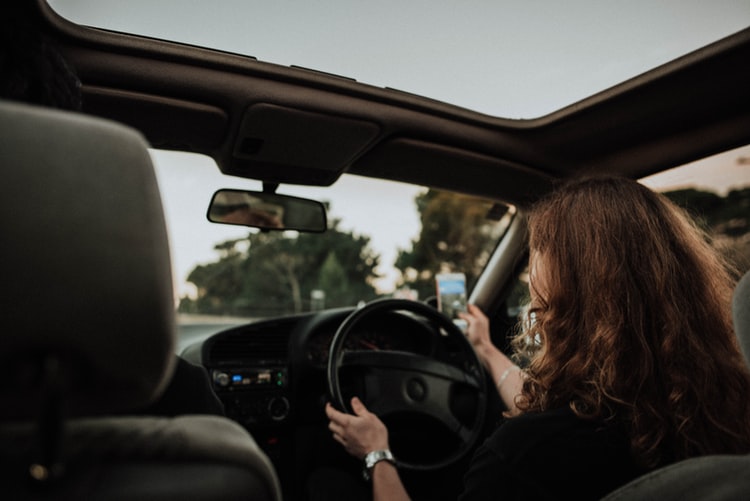Texting And Driving: The Conjunction Is OR
The Roman poet Decimus Iunius Iuvenalis (“Juvenal” in English) lived in the 2nd century AD. In his book of satirical poems, he wrote: Rarus enim ferme sensus communis – “common sense is generally rare”. Twenty centuries later, after we’ve sent man to the moon and connected the world in zettabytes of data, the truth of his simple claim persists. How else can one explain the fact that at any given moment, approximately 660,000 drivers in the US are glancing at their phones or texting a ‘quick’ reply while behind the wheel of an automobile?

“It only takes five seconds to glance at my message box, what could go wrong?”, could be the argument of anyone who texts while driving. Think of the physics involved. When you are driving at a speed of, say, 55 miles per hour, you would cover about 133 yards in five seconds, which is 13 yards more than the width of a football field! You have just driven across a football field, with eyes off the road.
OK, say you are not driving at 55 mph, but at 45 mph. You have crossed an entire block with eyes off the road. At 35 mph, you have crossed four fifths of the height of the Statue of Liberty . At a glacial speed of 25 mph, you have still crossed a fallen Leaning Tower of Pisa, blindfolded.
Does that not make you shudder?
Let’s leave physics behind and look at statistics. According to the National Highway Traffic Safety Administration, distracted driving killed 2841 people on the road in 2018. “Texting while driving” has now replaced “drinking and driving” as the leading cause of death among teenage drivers and cell phones have been implicated in 1.6 million – yes million – automobile crashes, fatal or otherwise, each year in the US – this is 64 percent of all vehicle accidents.
A common counter argument is the use of hands free and voice control options to text, as being harmless (as the eyes are not off the roa)d. The act of driving is not a disjointed use of body parts. Nor is the human brain designed for multitasking. Studies have shown that the reaction time of drivers using devices, irrespective of whether it is hands-on or hands-free, is 40% slower than those who are not distracted. At a driving speed of 25 mph, this slower reaction time leads to a delayed response distance of 12 yards – equivalent to running over two and a half Volkswagen Beetles!

An AT&T survey has shown that although 90% of American drivers know that texting while driving is dangerous, 49% continue to engage in the activity. Did you just hear Juvenal laugh across the ages?
Why do we engage in such obviously harmful activities? The compulsive checking of the mobile phone is much like any other addiction; “happy chemicals” are released in the brain while engaging in the habit. The happy chemicals, in addition to, of course, making us “happy”, can give us a false sense of productivity, until that inevitable crash occurs – both in the brain and the car.
Many states in the US have framed laws to prevent texting and driving, and insurance companies hike up premiums in cases of tickets issued for such transgressions. But laws and rules are external and are useful only when the discipline starts from within.
Some common sense (which should NOT be rare) steps to prevent texting-driving related accidents include switching off devices when driving, or putting it on silent. Smart automobiles have signal jamming facilities to prevent cell phone use while driving. For example, Nissan’s Signal Shield is a box designed to block smartphone signals.

If it is important to have the mobile phone functional while driving, there are other things that can be done:
- Technology does not always kill, it can save. Many gadgets have built in facilities to prevent device usage when driving. For example, the “Do not disturb while driving” feature in Apple devices may be turned on via Settings > Control Center > Customize Controls > Do Not Disturb While Driving. There are apps such as Cellcontrol and Lifesaver help one to not use the phone while behind the wheel.
- Out of sight could be out of mind. Putting your mobile out of reach (i.e. the trunk or rear seat) can delay our reaction to a ping or ring because looking at the cell phone and responding to the message would require impossible manoeuvres to reach the gadget. The solution would be to ignore the ping or pull over to check it – both perfectly safe options while driving.
- Delegate phone activities to others in the car who are not actively engaged in driving. On the up-side, it may stop backseat drivers from driving you crazy.
- If you are a passenger in a vehicle, the driver of which engages in dangerous practices such as texting while driving, it is not inappropriate to inform them of your discomfort as politely or impolitely as the relationship permits. You wouldn’t get into a car driven by a drunk driver – the National Highway Traffic Safety Administration reports that driving a vehicle while texting is six times more dangerous than intoxicated driving.
It also helps to read articles like this one to scare you. Sometimes fear is the best incentive to stop a bad habit.
But it shouldn’t go that far, should it?
Writing credit: Authored by Lakshmi, a Mobicip mom who researches extensively on digital citizenship and internet safety.
Keep in touch with the latest on parenting, technology, and education. Subscribe to the Mobicip newsletter. Learn more at www.mobicip.com.





